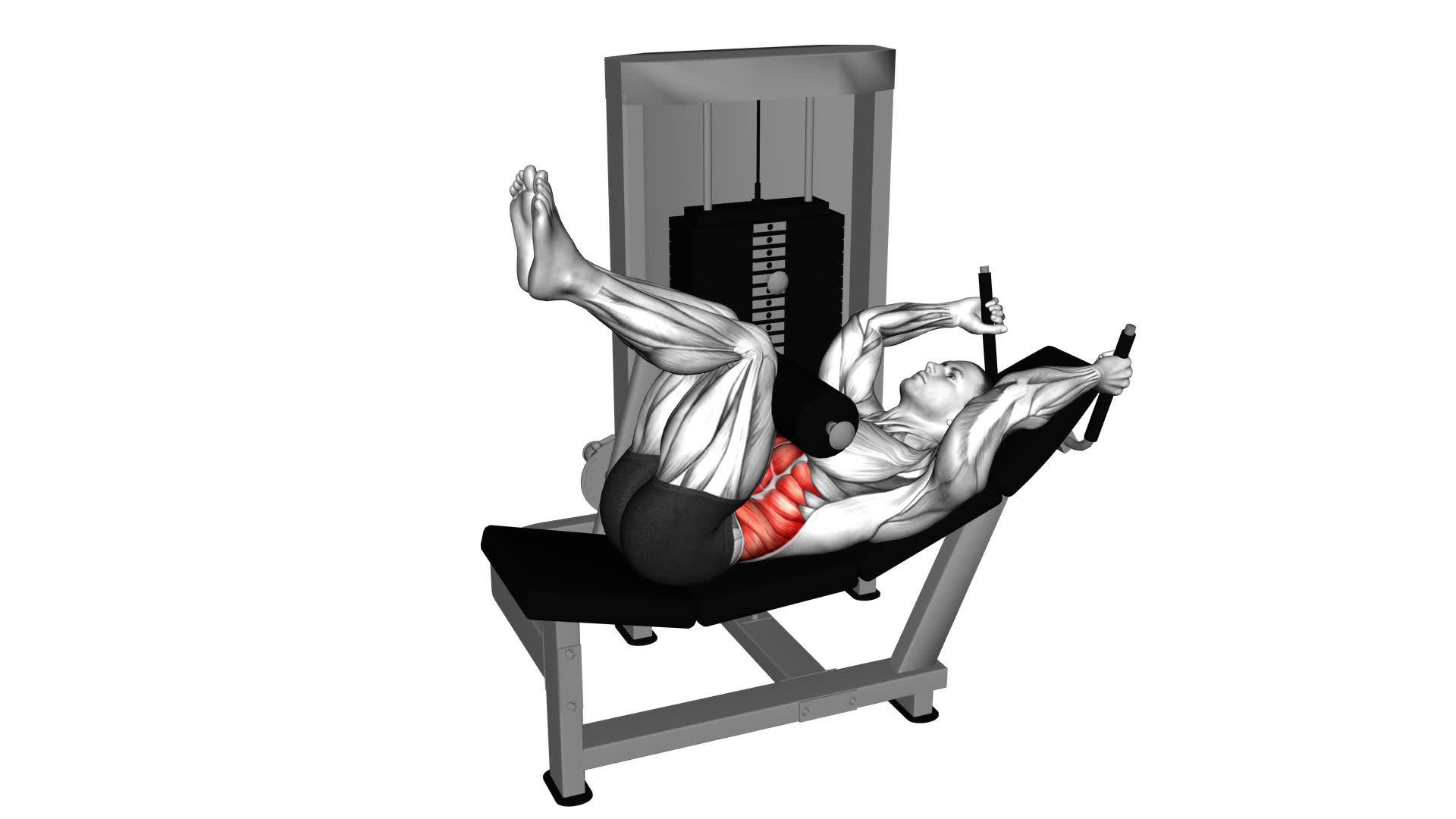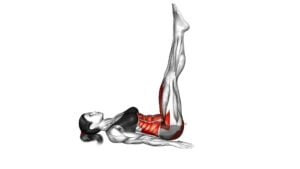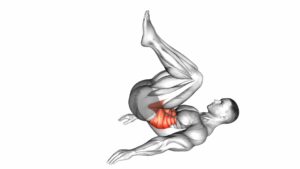Lever Lying Leg Raise Bent Knee – Video Exercise Guide & Tips

Looking to strengthen your lower body? The Lever Lying Leg Raise Bent Knee is a fantastic exercise for targeting your abs, hips, and thighs.
Watch This Exercise Video
In this video exercise guide, we'll show you the proper technique and offer valuable tips to maximize its effectiveness.
Avoid common mistakes and discover modifications and progressions to challenge yourself.
Get ready to take your leg workout to the next level with this powerful move. Let's dive in!
Key Takeaways
- The lever lying leg raise bent knee targets and strengthens lower abdominal muscles.
- Engaging core muscles throughout the exercise is important for proper form and effectiveness.
- Modifications and progressions, such as using ankle weights or trying single-leg variations, can be used to adjust the intensity of the exercise.
- Gradually increasing intensity and incorporating variety with alternative exercises can help prevent injury and maximize results.
Benefits of the Lever Lying Leg Raise Bent Knee
The Lever Lying Leg Raise Bent Knee offers a variety of benefits for your lower abdominal muscles. This exercise effectively targets and strengthens your rectus abdominis, transverse abdominis, and obliques. By engaging these muscles, you can improve your core stability and enhance your overall athletic performance.
To properly activate your core during the Lever Lying Leg Raise Bent Knee, start by lying flat on your back with your legs extended and your hands placed underneath your lower back for support. Bend your knees and bring them towards your chest. Slowly raise your legs towards the ceiling, keeping your core tight and your lower back pressed against the floor. Pause for a moment at the top of the movement, then slowly lower your legs back to the starting position. Remember to breathe throughout the exercise, exhaling as you raise your legs and inhaling as you lower them.
Proper Technique for Performing the Lever Lying Leg Raise Bent Knee
To perform the Lever Lying Leg Raise Bent Knee with proper technique, start by positioning yourself on your back with legs extended and hands supporting your lower back. Follow these guidelines to ensure you're performing the exercise correctly:
- Engage your core muscles by drawing your navel towards your spine.
- Bend your knees and lift your feet off the ground, bringing your thighs perpendicular to the floor.
- Slowly lower your legs back down towards the ground without allowing your lower back to arch or lose contact with your hands.
- Pause briefly at the bottom and then raise your legs back up to the starting position.
- Repeat for the desired number of repetitions.
It's important to avoid common mistakes when performing this exercise, such as:
- Allowing your lower back to arch or lose contact with your hands.
- Using momentum to swing your legs up instead of using controlled movements.
- Raising your legs too high, which can strain your lower back.
If you're looking to modify or progress the Lever Lying Leg Raise Bent Knee, consider these options:
- Modification: Perform the exercise with your legs bent at a smaller angle to reduce the intensity.
- Progression: Add ankle weights or hold a dumbbell between your feet to increase resistance.
Common Mistakes to Avoid During the Lever Lying Leg Raise Bent Knee
Avoid these common mistakes when performing the Lever Lying Leg Raise Bent Knee to ensure proper form and maximize the effectiveness of the exercise.
One common mistake is allowing your lower back to lift off the ground during the movement. This can put excessive strain on your lower back and reduce the effectiveness of the exercise. To avoid this, engage your core muscles and keep your lower back firmly pressed into the ground throughout the entire movement.
Another mistake to avoid is using momentum to swing your legs up. This not only takes away from the targeted muscle engagement, but it also increases the risk of injury. Instead, focus on using the strength of your abdominal muscles to lift your legs in a slow and controlled manner.
Lastly, avoid lifting your legs too high. While it may seem like lifting them higher will provide a better workout, it can actually strain your hip flexors and decrease the engagement of your abdominal muscles. Aim to lift your legs to a height where you feel a strong contraction in your abs, but without compromising your form.
Modifications and Progressions for the Lever Lying Leg Raise Bent Knee
To modify and progress the Lever Lying Leg Raise Bent Knee exercise, you can incorporate variations that challenge different muscle groups and increase the intensity of the movement. Here are some modifications and progressions you can try:
- Single-leg lever lying leg raise: Instead of raising both legs together, lift one leg while keeping the other extended on the ground. This variation targets the core and hip flexors more intensely.
- Weighted lever lying leg raise: Hold a dumbbell or a weight plate between your feet while performing the exercise. This adds resistance and increases the difficulty of the movement.
- Hanging lever lying leg raise: If you have access to a pull-up bar, you can perform the leg raise while hanging. This requires more upper body strength and engages the shoulders and grip as well.
- Tempo lever lying leg raise: Slow down the lowering phase of the movement, taking 3-4 seconds to lower your legs back to the starting position. This increases time under tension and makes the exercise more challenging.
- Advanced tuck lever lying leg raise: As you become more proficient, you can progress to a more advanced variation by tucking your knees towards your chest as you raise your legs. This further engages the lower abs and hip flexors.
Incorporating these modifications and progressions into your Lever Lying Leg Raise Bent Knee routine can help you target specific muscle groups and continue challenging yourself as you progress. Remember to maintain proper form and listen to your body to avoid injury.
Tips for Maximizing the Effectiveness of the Lever Lying Leg Raise Bent Knee
For maximum effectiveness of the Lever Lying Leg Raise Bent Knee, focus on maintaining proper form and engaging your core throughout the movement. By following these tips, you can maximize the benefits of this exercise and target your lower abs effectively.
To enhance the effectiveness of the Lever Lying Leg Raise Bent Knee, consider incorporating alternative exercises into your routine that specifically target the lower abs. Exercises such as hanging leg raises, bicycle crunches, and reverse crunches can help engage the lower abdominal muscles and provide variety to your workout.
If you're looking to incorporate the Lever Lying Leg Raise Bent Knee into a home workout routine, there are a few options. You can invest in a lever lying leg raise bench, which is specifically designed for this exercise. Alternatively, you can use a sturdy chair or bench to support your upper body while performing the leg raises. Just make sure to secure the bench or chair against a wall to ensure stability.
Remember to start with proper form and gradually increase the intensity and volume of the exercise as your strength improves. By consistently engaging your core and incorporating alternative exercises, you can maximize the effectiveness of the Lever Lying Leg Raise Bent Knee and achieve your fitness goals.
Sample Workout Routine Incorporating the Lever Lying Leg Raise Bent Knee
To incorporate the Lever Lying Leg Raise Bent Knee into your workout routine, continue engaging your core and focusing on proper form throughout the exercise. This exercise targets your lower abdominal muscles and hip flexors, helping to strengthen and tone your core.
Here's a sample workout routine that incorporates the Lever Lying Leg Raise Bent Knee:
- Warm up: Perform some light cardio exercises such as jogging or jumping jacks for 5-10 minutes to get your heart rate up and prepare your body for the workout.
- Main exercise: Start with 3 sets of 10-12 repetitions of the Lever Lying Leg Raise Bent Knee. Remember to maintain control and avoid swinging your legs.
- Superset: Pair the Lever Lying Leg Raise Bent Knee with another core exercise, such as plank holds or Russian twists. Perform 3 sets of 10-12 repetitions of each exercise, alternating between them with minimal rest.
- Variation: To add intensity, you can try straightening your legs and performing the Lever Lying Leg Raise with straight knees.
- Cool down: Finish your workout with some light stretching exercises to help reduce muscle soreness and promote flexibility.
Frequently Asked Questions
Can the Lever Lying Leg Raise Bent Knee Help With Improving Flexibility in the Hips?
Yes, the lever lying leg raise bent knee can help improve flexibility in your hips. This exercise specifically targets the hip flexors, which are responsible for the movement and flexibility of your hips. By regularly performing this exercise, you can increase the range of motion in your hips and improve overall hip flexibility.
The lever lying leg raise bent knee offers several benefits, including strengthening the hip muscles and reducing the risk of hip injuries.
Is It Necessary to Use a Lever Machine to Perform the Lever Lying Leg Raise Bent Knee, or Can It Be Done Without One?
Yes, you can perform the lever lying leg raise bent knee without a machine. This exercise can be done on the floor or on a bench, using your bodyweight for resistance.
Variations of the lever lying leg raise bent knee can also be done with the assistance of a stability ball or resistance bands. These variations can target different muscles and add variety to your workout routine.
How Long Should I Hold the Top Position of the Lever Lying Leg Raise Bent Knee for Maximum Benefit?
To maximize the benefits of the lever lying leg raise bent knee, it's important to hold the top position for an adequate amount of time. Without the context of the exercise guide, it's difficult to provide an exact duration.
However, to progress in this exercise, you can gradually increase the time you hold the top position. Additionally, adding resistance, such as ankle weights or a weighted vest, can further challenge your muscles and enhance the effectiveness of this exercise.
Can the Lever Lying Leg Raise Bent Knee Be Modified to Target Specific Muscles, Such as the Inner Thighs or Glutes?
To target specific muscles like your inner thighs or glutes, modifications can be made to the lever lying leg raise bent knee exercise. By adjusting the placement of your feet or the angle of your legs, you can focus on engaging these muscle groups more effectively.
Inner thigh exercises can help tone and strengthen this area, while glute activation exercises can help build and lift your buttocks.
Incorporating these modifications will enhance your workout and help you achieve your desired results.
Are There Any Alternative Exercises That Can Be Incorporated Into a Workout Routine Alongside the Lever Lying Leg Raise Bent Knee for Added Variety and Overall Leg Strength?
Looking to add variety and strengthen your legs? Consider incorporating alternative leg exercises into your routine alongside the lever lying leg raise bent knee.
By doing so, you can target different muscle groups and keep your workouts interesting. Leg exercises like squats, lunges, and step-ups offer great benefits for overall leg strength and can be a valuable addition to your fitness regimen.
Don't be afraid to mix it up and challenge your legs in new ways!
Conclusion
In conclusion, the lever lying leg raise bent knee is a beneficial exercise that targets the lower abdominal muscles and hip flexors.
It's important to maintain proper technique and avoid common mistakes to maximize its effectiveness.
Modifications and progressions can be made to suit individual fitness levels.
By incorporating this exercise into a well-rounded workout routine, you can strengthen your core and improve overall muscle balance.

Author
Years ago, the spark of my life’s passion ignited in my mind the moment I stepped into the local gym for the first time. The inaugural bead of perspiration, the initial endeavor, the very first surge of endorphins, and a sense of pride that washed over me post-workout marked the beginning of my deep-seated interest in strength sports, fitness, and sports nutrition. This very curiosity blossomed rapidly into a profound fascination, propelling me to earn a Master’s degree in Physical Education from the Academy of Physical Education in Krakow, followed by a Sports Manager diploma from the Jagiellonian University. My journey of growth led me to gain more specialized qualifications, such as being a certified personal trainer with a focus on sports dietetics, a lifeguard, and an instructor for wellness and corrective gymnastics. Theoretical knowledge paired seamlessly with practical experience, reinforcing my belief that the transformation of individuals under my guidance was also a reflection of my personal growth. This belief holds true even today. Each day, I strive to push the boundaries and explore new realms. These realms gently elevate me to greater heights. The unique combination of passion for my field and the continuous quest for growth fuels my drive to break new ground.







